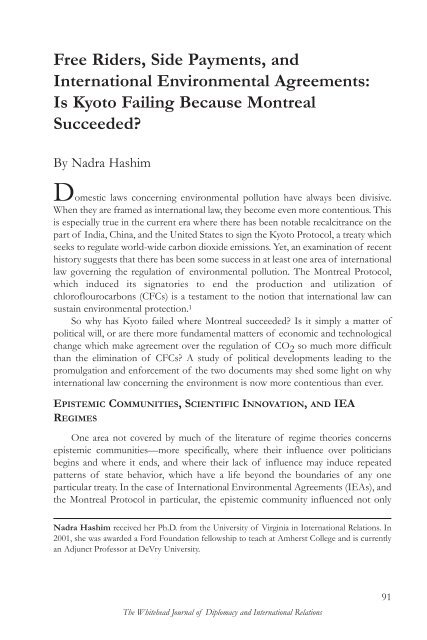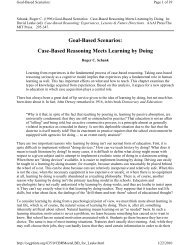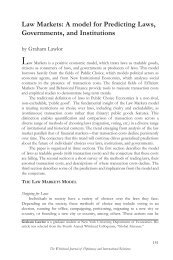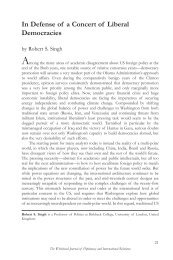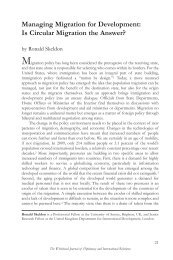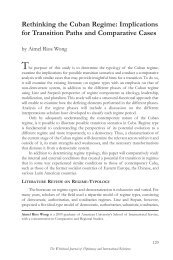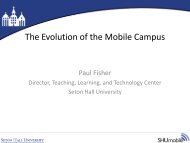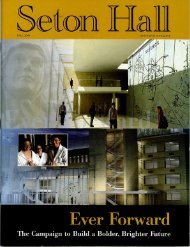Free Riders, Side Payments, and International Environmental ...
Free Riders, Side Payments, and International Environmental ...
Free Riders, Side Payments, and International Environmental ...
You also want an ePaper? Increase the reach of your titles
YUMPU automatically turns print PDFs into web optimized ePapers that Google loves.
<strong>Free</strong> <strong>Riders</strong>, <strong>Side</strong> <strong>Payments</strong>, <strong>and</strong><br />
<strong>International</strong> <strong>Environmental</strong> Agreements:<br />
Is Kyoto Failing Because Montreal<br />
Succeeded?<br />
By Nadra Hashim<br />
Domestic laws concerning environmental pollution have always been divisive.<br />
When they are framed as international law, they become even more contentious. This<br />
is especially true in the current era where there has been notable recalcitrance on the<br />
part of India, China, <strong>and</strong> the United States to sign the Kyoto Protocol, a treaty which<br />
seeks to regulate world-wide carbon dioxide emissions. Yet, an examination of recent<br />
history suggests that there has been some success in at least one area of international<br />
law governing the regulation of environmental pollution. The Montreal Protocol,<br />
which induced its signatories to end the production <strong>and</strong> utilization of<br />
chloroflourocarbons (CFCs) is a testament to the notion that international law can<br />
sustain environmental protection. 1<br />
So why has Kyoto failed where Montreal succeeded? Is it simply a matter of<br />
political will, or are there more fundamental matters of economic <strong>and</strong> technological<br />
change which make agreement over the regulation of CO 2 so much more difficult<br />
than the elimination of CFCs? A study of political developments leading to the<br />
promulgation <strong>and</strong> enforcement of the two documents may shed some light on why<br />
international law concerning the environment is now more contentious than ever.<br />
EPISTEMIC COMMUNITIES, SCIENTIFIC INNOVATION, AND IEA<br />
REGIMES<br />
One area not covered by much of the literature of regime theories concerns<br />
epistemic communities—more specifically, where their influence over politicians<br />
begins <strong>and</strong> where it ends, <strong>and</strong> where their lack of influence may induce repeated<br />
patterns of state behavior, which have a life beyond the boundaries of any one<br />
particular treaty. In the case of <strong>International</strong> <strong>Environmental</strong> Agreements (IEAs), <strong>and</strong><br />
the Montreal Protocol in particular, the epistemic community influenced not only<br />
Nadra Hashim received her Ph.D. from the University of Virginia in <strong>International</strong> Relations. In<br />
2001, she was awarded a Ford Foundation fellowship to teach at Amherst College <strong>and</strong> is currently<br />
an Adjunct Professor at DeVry University.<br />
The Whitehead Journal of Diplomacy <strong>and</strong> <strong>International</strong> Relations<br />
91
92<br />
The Whitehead Journal of Diplomacy <strong>and</strong> <strong>International</strong> Relations<br />
HASHIM<br />
how scientific knowledge was disbursed but also how compromise could be<br />
achieved. Robert Keohane describes international institutions as providing “an array<br />
of persistent <strong>and</strong> connected rules that prescribe behavior roles, constrain activity,<br />
<strong>and</strong> shape expectations.” 2 Throughout the meetings that lead to the convening of the<br />
protocol, diplomatic representatives of the scientific community, acting through<br />
international institutions, helped formulate both the rules of the treaty, <strong>and</strong> perhaps<br />
more importantly, the exceptions to the rules. It was the exception to protocol rules<br />
that made treaty negotiation possible, at least in the short run, but made enforcement<br />
more difficult.<br />
THE HISTORY AND STUDY OF CFCS<br />
The development of CFCs reflects the history of twentieth century economic<br />
advancements. Dubbed the second industrial revolution, <strong>and</strong> spanning the years<br />
1910–1950, American industrial mobilization during World Wars I <strong>and</strong> II created the<br />
infrastructure for the mass production of various household accessories. One of the<br />
first <strong>and</strong> most popular br<strong>and</strong>s of CFC, Freon, was developed by Thomas Midgley<br />
<strong>and</strong> Charles Kettering of General Motors. 3 Kinetic Chemicals produced Freon—or<br />
dichlorofluromethane, CFC 114—as a non-toxic alternative to several noxious gases<br />
commonly used in refrigeration, namely ammonia, chloromethane, <strong>and</strong> sulfur<br />
dioxide. 4 CFCs, such as dichloroflouromethane, are the most widely known family of<br />
chemical compounds known as haloalkanes, sometimes referred to as halogen<br />
compounds or halons. In the 1930s, Freon was used as a refrigerant in commercial<br />
<strong>and</strong> retail outlets. By the 1950s, 50 percent of farms <strong>and</strong> 90 percent of urban homes<br />
had Freon dependent refrigerators. By the 1960s, many cars were air-conditioned<br />
with some type of Freon refrigerant, <strong>and</strong> by the 1990s, when the push to phase CFCs<br />
began, 94 percent of all cars had Freon-based air conditioning. 5 Chloroflourocarbons<br />
became unpopular as a result of three developments: the energy crisis of the 1970s,<br />
Molina <strong>and</strong> Rol<strong>and</strong>’s Ozone depletion theory of 1974, <strong>and</strong> the “ozone hole”<br />
discovered over Antarctica in 1985.<br />
THE ENERGY CRISIS AND THE OZONE LEARNING CURVE<br />
The energy crisis of the early 1970s was far reaching <strong>and</strong> affected energy costs<br />
beyond petroleum use in automobiles; it also affected electricity. 6 Air-conditioning<br />
rates soared <strong>and</strong> the US Congress m<strong>and</strong>ated thermostat settings to regulate<br />
consumption. The refrigerant industry, Dupont more specifically, began to research<br />
refrigerants that might work more efficiently. The industry’s primary concern was<br />
finding a way to make <strong>and</strong> provide refrigerants that were cheaper. There was less<br />
concern regarding how “clean” this energy was until academic research began to<br />
explore a correlation between haloalkanes, particularly CFCs, <strong>and</strong> ozone depletion. 7<br />
However, by the mid 1970s, there were a variety of academic studies linking<br />
CFCs with the pollution of the environment. 8 In 1974, Frank Sherwood Rowl<strong>and</strong>,<br />
Chemistry Professor at the University of California, <strong>and</strong> Mario Molina, a chemistry
IS MONTREAL FAILING BECAUSE KYOTO SUCCEEDED?<br />
post-doctoral associate, released a study which indicated that Freon drifted into the<br />
atmosphere, producing free chlorine (Cl), which destroys ozone. 9<br />
In 1976, the US Academy of Sciences released a report concluding that<br />
“credible scientific evidence” supported the ozone depletion theory. 10 The same<br />
year, the governing council of the United Nations <strong>Environmental</strong> Program (UNEP)<br />
began plans for a conference which would be hosted by the US government. In 1977,<br />
the <strong>International</strong> Conference on Ozone, attended by representatives of various<br />
nations, released the World Plan of Action on the Ozone Layer. The push to remove<br />
CFCs, or at least their use in aerosol cans, commenced, <strong>and</strong> the US implemented its<br />
aerosol ban in 1978. While the aerosol ban enjoyed limited success, the effort to<br />
exercise a fuller ban on CFCs in refrigerants, air conditioners, fire extinguishers, <strong>and</strong><br />
the like was more difficult. Between 1978 <strong>and</strong> 1985, when 20 nations signed the<br />
Vienna Convention, which established the framework for the Montreal Protocol,<br />
there was much hesitancy <strong>and</strong> delay.<br />
Among the obstacles to agreement was an assessment by the National Academy<br />
that damage to the ozone may have been overstated by Rowl<strong>and</strong> <strong>and</strong> Molina <strong>and</strong><br />
others. Other impediments included the halocarbon industry’s resistance to<br />
developing CFC alternatives, <strong>and</strong> the Reagan Administration’s general disinterest in<br />
environmental issues. Finally, several important members of the European<br />
community stated their outright refusal to consider most CFC bans. 11 Attitudes<br />
began to change in the mid 1980s when the American government modified its<br />
position on enacting a full scale ban on CFCs. This was due in no small measure to<br />
a series of reports released between 1979–1981 that asserted that there was a marked<br />
depletion in stratospheric ozone due to the release of CFCs <strong>and</strong> other gases into the<br />
atmosphere. 12<br />
Late in 1984, a British scientist named Joseph Farman, from the British<br />
Antarctic Survey, measured <strong>and</strong> published a grim survey of atmospheric ozone in<br />
Antarctica. 13 There was such depletion of ozone (O 3 ) in the atmosphere that it was<br />
soon dubbed “the ozone hole.” The hole stretched millions of miles over an area<br />
larger than Russia <strong>and</strong> Brazil combined. 14 Published in early 1985, Farman’s report<br />
had the effect of verifying Rowl<strong>and</strong> <strong>and</strong> Molina’s dire prediction that, left unabated,<br />
chemical byproducts might permanently destroy the environment. Farman’s study<br />
coincided with the meeting of the Vienna Convention, which was the precursor to<br />
the Montreal Protocol. By the beginning of 1986, the halocarbon industry, led by<br />
Dupont, finally relented in the face of incontrovertible scientific proof. Dupont<br />
reported that it was developing alternatives to CFC, which could be used in air<br />
coolers <strong>and</strong> refrigerators as early as 1991. 15 The Dupont announcement was a<br />
breakthrough, as the chemical manufacturers had been one of he strongest sources<br />
of opposition. 16<br />
Led by the Dupont Corporation, which accounted for more than 25 percent of<br />
the international market, the refrigerant industry assured the US government that<br />
because of new technological innovations, including a variety of less damaging<br />
halocarbons refrigerants, existing CFC patents, owned mostly by American<br />
www.journalofdiplomacy.org<br />
93<br />
Winter/Spring 2009
94<br />
The Whitehead Journal of Diplomacy <strong>and</strong> <strong>International</strong> Relations<br />
HASHIM<br />
companies, would not need renewing. 17 Technological innovation made a ban of<br />
CFCs possible, but political will was still guided by pragmatism. Forty-three nations<br />
signed the Montreal Protocol. These nations agreed to the treaty because, according<br />
to Dr. Mustafa Tolba, former director of the United Nations <strong>Environmental</strong><br />
Program, “it set up a world-wide schedule for phasing out CFCs, which [were] no<br />
longer protected by patents. This provided companies with an equal opportunity to<br />
make new, more profitable compounds.” 18<br />
In fact, the Vienna Convention <strong>and</strong> the Montreal Protocol were the culmination<br />
of efforts of a broad network of atmospheric scientists <strong>and</strong> an environmental<br />
epistemic community aimed at influencing governments <strong>and</strong> compelling the<br />
chemical companies to limit or alter their manufacture of haloalkanes <strong>and</strong> CFCs in<br />
particular. The irony of the Montreal Protocol was its success was largely the result<br />
of the fact that big business joined a small community of environmental scientific<br />
experts in what would become a joint effort to regulate CFCs in a manner that<br />
compelled state action, rather than the other way around.<br />
EPISTEMIC COMMUNITIES, REGIME THEORY AND FREE RIDERS<br />
It is axiomatic that the more heterogeneous the epistemic community, the less<br />
coherent the regime. This may be especially true in the field of environmental<br />
regulation where members of the epistemic community include members as diverse<br />
as chemical manufacturers as well as advocates of alternative or “clean” energies.<br />
One of the keys in comprehending how international regimes are created <strong>and</strong> how<br />
they, in turn, create international law is to first gain some insight into the nature of<br />
epistemic communities. 19 Peter Hass defines epistemic communities as “a network of<br />
professionals with recognized expertise <strong>and</strong> competence in a particular domain <strong>and</strong><br />
an authoritative claim to policy relevant to knowledge with that domain or issue<br />
area.” 20 Epistemic communities, like government institutions, are bound by<br />
international <strong>and</strong> national structural realities. However, unlike state institutions, they<br />
are flexible <strong>and</strong> can function both within the institutions of a particular state while<br />
also acting as transnational participants in a community that transcends national<br />
boundaries. They shed light on complex concepts (such as atmospheric degradation),<br />
they help define the self-interest of the state, <strong>and</strong> they can assist in formulating<br />
policy. 21<br />
Last but not least, “epistemic communities apply their causal knowledge to a<br />
policy enterprise subject to their normative objectives,” <strong>and</strong> as such, tend to be small<br />
distinctive groups with authoritative knowledge <strong>and</strong> equally strong opinions. 22 In<br />
1970, the epistemic community concerned with ozone depletion consisted of a few<br />
scientists mostly working as academics. These independent researchers largely shared<br />
their findings regarding ozone depletion only with one another. However, by 1976,<br />
the US Academy of Science released its report authenticating Rowl<strong>and</strong> <strong>and</strong> Molina’s<br />
research on CFC induced ozone depletion. That same year, UNEP hosted an<br />
international conference calling for an ozone plan of action. Thus, the scattered<br />
research of a small epistemic community of atmospheric researchers gained
IS MONTREAL FAILING BECAUSE KYOTO SUCCEEDED?<br />
attention in two important quarters. After the ban on CFCs in aerosol cans, the<br />
epistemic community of ozone academics garnered even more respect.<br />
Hoping to stem the tide of regulation, the producers of CFCs <strong>and</strong> chemical<br />
manufacturers both in the US <strong>and</strong> abroad agreed to comply with a freeze on certain<br />
compounds while generally rebutting the science of<br />
ozone depletion. As late as the mid–1980s <strong>and</strong><br />
throughout meetings of the Vienna Convention <strong>and</strong> the<br />
Montreal Protocol, the Alliance for a Responsible CFC, a<br />
coalition of chemical manufacturers, systematically<br />
resisted a freeze on halon production. The alliance argued<br />
that despite the evidence of millions of miles of ozone<br />
depletion over Antarctica, there were no observations of<br />
ozone depletion anywhere else. 23 In a argument that<br />
would be echoed years later when CO 2 capture <strong>and</strong> the Kyoto Protocol were at<br />
stake, the chemical manufacturers argued that the US accounted for only a quarter<br />
of global use of CFCs, <strong>and</strong> therefore any American agreement to freeze production<br />
would be useless without guarantees from other nations. 24<br />
The Reagan Administration seemed ambivalent, if not hostile, to pursuing an<br />
agenda of environmental protection until 1983, when the White House replaced<br />
EPA administrator Ann Gorusch with William Ruckleshaus, <strong>and</strong> then a year later<br />
with Lee Thomas,who by various accounts was even more progressive than<br />
Ruckleshaus. Under Lee Thomas, the EPA became a leading force in the<br />
international coalition of states committed to promoting ozone protection. 25 In the<br />
years leading to the Montreal Protocol, the EPA, NASA, <strong>and</strong> OES were “staffed by<br />
members of the [environmental] epistemic community,” who were uniquely poised<br />
to take leadership in the effort to protect the ozone layer. 26<br />
As for the leadership on the legislative <strong>and</strong> Congressional fronts, there was also<br />
more support for ozone protection than there had been when Rowl<strong>and</strong> <strong>and</strong> Molina<br />
released their report ten years earlier. US Senators John Chafee <strong>and</strong> Max Baucus<br />
sponsored bills which addressed both an immediate freeze <strong>and</strong> gradual reduction in<br />
the production of CFCs. 27 At the State Department, John Negroponte <strong>and</strong> Deputy<br />
Assistant Secretary of State Richard Benedick rallied the international effort to add<br />
signatories to the Montreal Protocol. 28 Benedick, the head of the US delegation to<br />
the Montreal Protocol, attributes the success to four variables. 29 First, there was the<br />
role of what Benedick calls “the best scientists…prepared to undertake coordinated<br />
actions.” 30 In addition to the role of the epistemic community, Benedick also<br />
recognizes three other factors including the “power of knowledge <strong>and</strong> public<br />
opinion,” the mediating “activities of multilateral institutions,” <strong>and</strong> the steadfast<br />
commitment of “nations, policies <strong>and</strong> leadership.” 31<br />
A discussion which has not been given sufficient attention concerns how<br />
epistemic communities <strong>and</strong> their diplomatic representatives, acting through<br />
international regimes, may help create certain patterns of state behavior, such as freeriding,<br />
which often define the regime beyond the life of a particular treaty. In the case<br />
www.journalofdiplomacy.org<br />
95<br />
In the case of the<br />
negotiations at the<br />
Montreal Protocol, it<br />
was not the rules so<br />
much as the exception<br />
to the rules that made<br />
short-term treaty<br />
negotiation posssible.<br />
Winter/Spring 2009
96<br />
The Whitehead Journal of Diplomacy <strong>and</strong> <strong>International</strong> Relations<br />
HASHIM<br />
of the negotiations at the Montreal Protocol, it was not the rules so much as the<br />
exception to protocol rules, that made short-term treaty negotiation possible.<br />
However, these short-term shortcuts may have made attaining consensus on future<br />
treaties more difficult.<br />
If the years between 1974–1984 signified the emergence of an epistemic<br />
community on ozone, the years 1984–1994 constituted a period when the epistemic<br />
community began to establish a global regime for protection of the atmosphere. One<br />
of the most obvious indications that the epistemic community had some success in<br />
this area of regime creation is reflected in the reception ozone research received in<br />
the early 1980s versus how such research was treated only a few years later. Rowl<strong>and</strong><br />
<strong>and</strong> Molina’s research, <strong>and</strong> Farman’s work in particular, became the basis for an<br />
exhaustive study jointly commissioned by the National Aeronautical <strong>and</strong> Space<br />
Agency (NASA), National Oceanic <strong>and</strong> Atmospheric Administration,(NOAA), the<br />
US Federal Aviation Association(FAA), UNEP, <strong>and</strong> the German Ministry for<br />
Research <strong>and</strong> Technology. 32 Published in 1986, the NASA study confirmed that<br />
Farman’s ozone depletion theory was a core scientific truth which would become the<br />
basis for epistemic consensus. Thus, ozone preservationists had succeeded where so<br />
many other regulatory epistemic communities had failed, helping to launch a regime<br />
powerful enough to formulate legal remedies that would be observed internationally.<br />
Despite the power of this new regime, the effort to regulate CFCs had equally<br />
committed opponents. There were many business interests in America <strong>and</strong> Europe,<br />
as well as several national governments aligned against any form of ozone<br />
agreement. By contrast, the leaders of the ozone epistemic community, Dr. Mustafa<br />
Tolba of UNEP <strong>and</strong> Richard Benedick of the US State Department, were insistent<br />
that the protocol promote the most stringent prohibitions possible. Once the<br />
epistemic community had support from representatives of state-sponsored<br />
institutions, such as the UNEP <strong>and</strong> the US State Department, these state actors<br />
could reach out trans-nationally to other states. Robert Keohane describes this<br />
development as the source of institutional power. In the case of ozone protection,<br />
the nations which formed a coalition <strong>and</strong> initiated efforts to develop an ozone<br />
regime came to be known as the Toronto Group. These lead states met in 1985,<br />
creating a framework called the Vienna Convention that would become the basis for<br />
the Montreal Protocol. 33<br />
The Toronto Group, which included Canada, the US, New Zeal<strong>and</strong> , <strong>and</strong> a<br />
number of Sc<strong>and</strong>inavian countries, represented the philosophy of the scientific<br />
community view <strong>and</strong> exerted what could be described as both epistemic <strong>and</strong><br />
“hegemonic leadership.” 34 The hegemonic leadership of the Toronto Group made it<br />
possible to develop strategies to try to recruit states that either completely opposed<br />
a ban on CFCs or those who were simply ambivalent.<br />
In addition to the outright opposition of the chemical manufacturers, there were<br />
also several important governments opposed to the prohibition of CFCs. As<br />
negotiations progressed, it became clear that the national <strong>and</strong> economic interests of<br />
several powerful European nations might deliver a stillborn Montreal Protocol.
IS MONTREAL FAILING BECAUSE KYOTO SUCCEEDED?<br />
Britain, France, <strong>and</strong>, to a lesser extent, Italy <strong>and</strong> West Germany led European<br />
Community (EC) representatives to push for a production cap rather than a<br />
complete freeze on production or regulation on consumption. 35 From December<br />
1986 to February 1987, meetings between various protocol delegations were<br />
consumed by a conflict between the US <strong>and</strong> EC over the range, the form, <strong>and</strong> the<br />
nature of controls of CFC regulation along with the scope of exemptions from such<br />
controls.<br />
OZONE SCIENCE VS OZONE BUSINESS: BUILDING CONSENSUS<br />
THROUGH GAME THEORY<br />
The narrative which describes the conflict between Europe <strong>and</strong> America is as<br />
simple <strong>and</strong> as complex a matter of economic growth <strong>and</strong> decline. The US was the<br />
largest producer of CFC 11 <strong>and</strong> 12 in 1974, the year Rowl<strong>and</strong> <strong>and</strong> Molina issued<br />
their ground-breaking report. At that time, the US accounted for 46 percent of the<br />
market, while the combined output of EC countries accounted for 38 percent. 36<br />
Between 1974 <strong>and</strong> 1985, EC countries’ production of CFC 11 <strong>and</strong> 12 grew to 45<br />
percent while US production slipped to 28 percent. 37 Quite simply, Europeans were<br />
still using CFC-propelled aerosols, while the American government had banned<br />
them nearly ten years earlier. Further, European nations were exporting one–third of<br />
their CFC production abroad, with the hope of exp<strong>and</strong>ing the market to less<br />
developed countries (LDCs). Having set production quotas on CFC 11 <strong>and</strong> 12 for<br />
the next few years, EC countries offered to place limits on the production of these<br />
two compounds but wanted to reserve the right to produce three other CFC <strong>and</strong> two<br />
halons which the Toronto Group also wanted to ban or freeze. 38<br />
Another point of contention was the form of control: should the protocol<br />
control production or consumption; should it ban CFCs <strong>and</strong> other halons; <strong>and</strong> if<br />
not, how long should a production freeze should last? 39 Of all the nations, five<br />
countries in the EC comprised almost the entire export market of haloalkanes to the<br />
developing countries, <strong>and</strong> as such wanted to restrict production, rather than<br />
consumption. The Toronto Group, along with Denmark <strong>and</strong> the Soviet Union,<br />
advocated a control on consumption. Ultimately, the parties agreed to a formulation<br />
which they dubbed “adjusted production,” placing a limit on consumption, but<br />
formulating an export quota as well. There was further disagreement about whether<br />
haloalkane production should be frozen or simply banned. The EC favored a freeze<br />
on production, while the US wanted a freeze followed by severe cuts in production<br />
which would approximate a ban. 40<br />
The EC <strong>and</strong> the US also locked horns over one of the most important areas of<br />
the international, namely, how scientific criteria should be evaluated <strong>and</strong> how such<br />
criteria should be used to exert control over signatories. Once again, the role of<br />
ozone scientists <strong>and</strong> the ozone epistemic community remained of vital importance.<br />
The US delegation argued that cuts in CFC <strong>and</strong> haloalkanes should occur<br />
automatically, barring new scientific information which suggested these compounds<br />
www.journalofdiplomacy.org<br />
97<br />
Winter/Spring 2009
98<br />
The Whitehead Journal of Diplomacy <strong>and</strong> <strong>International</strong> Relations<br />
HASHIM<br />
were not as harmful as CFC 11<strong>and</strong> 12. The EC argued that freezes beyond CFC 11<br />
<strong>and</strong> 12 should only occur if scientific information proved unequivocally that suspect<br />
haloalkanes were as harmful as CFC 11 <strong>and</strong> 12. 41 Knowing that such inquiry required<br />
years of study, the EC was buying time to export new compounds before an eventual<br />
ban would be required. Thus, the very architecture of protocol review became a<br />
central feature of international ozone diplomacy.<br />
The politics of the protocol became a game of strategy with the EC trying to<br />
enlist Japan <strong>and</strong> the Soviet Union to modify the Toronto Group’s push for a strong<br />
treaty. However, when Brussels replaced Britain as head of the delegation, when<br />
Germany <strong>and</strong> Switzerl<strong>and</strong> indicated it would accede to US levels of cuts, or even go<br />
beyond them, <strong>and</strong> when Denmark broke from ranks of the EC to join the position<br />
of the Toronto Group, it looked as if a more stringent treaty might prevail. In the<br />
early days of the treaty negotiations, the EC, under influence from European<br />
chemical manufacturers, suggested that the veracity of scientific findings regarding<br />
ozone completion should be disputed. 42<br />
In the last hours of treaty negotiations, EC delegates, under pressure from the<br />
epistemic community represented by UNEP <strong>and</strong> the US State Department, <strong>and</strong><br />
unwilling to accede to cutting <strong>and</strong> freezing timetables of the Toronto Group, turned<br />
briefly to legal maneuvers in the hopes of providing a<br />
hedge to complete compliance. In 1984, EC legal<br />
experts floated the idea that the EC commission had<br />
complete authority, called “exclusive competence,” to<br />
enforce or disallow any feature of the protocol. 43 In<br />
fact, at the Vienna Convention <strong>and</strong> into the early<br />
months of the Montreal Protocol, the EC adopted a dual track approach, one<br />
questioning the science of ozone depletion <strong>and</strong> the other maintaining a claim on<br />
exclusive statutory authority over protocol accession <strong>and</strong> compliance. 44 Ultimately,<br />
the EC members were given a concession of being treated individually for the<br />
purposes of production but agreed to be treated as a unit regarding consumption. In<br />
the lexicon of game theory, such arrangements are called side payments, which were<br />
established to prevent a bigger threat, namely free-riding.<br />
<strong>Free</strong> riding, otherwise known as defection or total non-compliance, is generally<br />
considered the least favorable outcome of a treaty promoting mutual cooperation. 45<br />
Generally, small actors—those with less power or international clout—are able to act<br />
as free riders. They have a lower profile <strong>and</strong> their deviation is not thought to be an<br />
impediment to cooperation, at least not in a broad sense. 46 <strong>Free</strong> riding is often more<br />
an affront than an impediment to the concept of multinational cooperation.<br />
However, the logic of cooperation suggests that parties who agree to participate in<br />
regulating a collective good are generally more committed to one another <strong>and</strong> to<br />
observing the rules of the agreement if they believe all parties are similarly<br />
compelled to preserve the collective good. 47 ...sometimes international<br />
agreements can only be<br />
realized when <strong>and</strong> if<br />
certain parties are offered<br />
a free riding option.<br />
Practically any strategy, including<br />
strategies which purchase cooperation, are preferred to free riding. Yet, sometimes<br />
international agreements can only be realized when <strong>and</strong> if certain parties are offered
IS MONTREAL FAILING BECAUSE KYOTO SUCCEEDED?<br />
the free riding option.<br />
PROVISIONAL FREE-RIDING: AN EPISTEMIC ALTERNATIVE TO<br />
DEFECTION<br />
The arrangement that allowed EC members to sign Montreal <strong>and</strong> have different<br />
st<strong>and</strong>ards for controlling production was an example of bargaining, or side<br />
payments, that gave reluctant EC countries a provisional free-ride. In reality, the<br />
substantive outcome was that UNEP <strong>and</strong> the US State Department compelled EC<br />
countries to commit to controlling the types of CFCs they export to the developing<br />
world. This arrangement was a provisional free-ride, constructed to discourage<br />
European defection from the effort to control CFCs <strong>and</strong> to prevent an even more<br />
damaging version of free riding or defection. The Toronto Group was especially<br />
keen that LDCs be given an incentive to sign the treaty, an incentive to refrain from<br />
developing CFC factories, <strong>and</strong> a grace period during which they could limit their<br />
importation of EC CFC products. These were the side payments which were given<br />
to EC countries; the protocol gave some time to export CFC products already in the<br />
pipeline, discouraging both EC <strong>and</strong> LDC defection, without resorting to the threat<br />
of embargo. 48<br />
LDCs were a constant source of concern for protocol conveners, <strong>and</strong> treaty<br />
brinksmanship was at its height when negotiations between the EC <strong>and</strong> the Toronto<br />
Group concerned the export <strong>and</strong> phased reduction of CFCs designated for the<br />
developing world. There were few LDCs represented in the talks leading to the<br />
protocol. Of those present, India <strong>and</strong> China played the most dominant role. China<br />
indicated a vague, if not totally committed desire to accede to the protocol. India,<br />
however, already possessed CFC production technology, which it purchased from US<br />
firms in the hopes of selling refrigerant products in various markets in the<br />
developing world. 49<br />
As of 1987, neither China nor India had reached the dizzying heights they would<br />
as newly industrializing nations at the dawning of a new millennium. In the years<br />
between the formulation of the protocol <strong>and</strong> its tenth anniversary, Chinese <strong>and</strong><br />
Indian ambivalence regarding CFC regulation would transform into reluctance <strong>and</strong><br />
then evasion. In the subsequent reviews <strong>and</strong> amendments to the Montreal protocol,<br />
especially those ensuring compliance in the export of frozen, or banned CFCs, the<br />
EC <strong>and</strong> LDCs continued to frustrate international compliance. In one of the<br />
paradoxes of global environmental governance, India <strong>and</strong> China, neither importing<br />
nor producing CFCs on the eve of the Montreal Protocol, delayed their accession to<br />
the treaty, only to become sources of CFCs smuggled into Europe <strong>and</strong> North<br />
America years later. 50<br />
The Montreal Protocol was not a perfect treaty; it was simply the best treaty<br />
given the complexity of the issue <strong>and</strong> the number of players. One feature of the<br />
protocol is that it created the context for the transmission of expert knowledge that<br />
became a resource of state-sponsored regime creation <strong>and</strong> formulation of<br />
www.journalofdiplomacy.org<br />
99<br />
Winter/Spring 2009
100<br />
The Whitehead Journal of Diplomacy <strong>and</strong> <strong>International</strong> Relations<br />
HASHIM<br />
environmental law. This was a strength, but it was also a liability. If the Montreal<br />
protocol created a regime by deriving its authority from state sanctioned epistemic<br />
experts, then in other contexts, especially where carbon dioxide regulation was<br />
concerned, the state could <strong>and</strong> would produce experts which would promote<br />
national interest over environmental protection.<br />
STUDYING CO 2 IN THE SHADOW OF THE INDUSTRIAL REVOLUTION<br />
The academic study of carbon dioxide (CO 2 ) preceded research concerning<br />
CFCs by more than one–hundred years. In the 1890s, research by Svante August<br />
suggested that human <strong>and</strong> plant waste created CO 2 , which warmed the atmosphere<br />
like a “hot-house,” or greenhouse. 51 For the next eight years, there was scattered<br />
research on the effects of CO 2 on the environment, but little captured public<br />
attention until the late 1970s, when the National Academy of Scientists published<br />
one report, which focused national attention on the specter of CO 2 -driven “global<br />
warming.” 52<br />
1979-1992: CO 2 AGREEMENT OR AVOIDANCE<br />
In 1979, the National Academy of Sciences (NAS) released a major scientific<br />
study regarding carbon dioxide. 53 The NAS report stated simply, “If carbon dioxide<br />
continues to increase, the study group finds no reason to doubt that climate changes<br />
will result, <strong>and</strong> no reason to believe that these changes will be negligible. A wait-<strong>and</strong>see<br />
policy may mean waiting until it is too late.” 54 Building on the findings of the<br />
NAS in 1980, the Carter Council of <strong>Environmental</strong> Quality published a widely<br />
circulated report which disclosed that “many scientists now believe that, if global<br />
fossil fuel use grows rapidly in the decades ahead, the accompanying carbon dioxide<br />
increases will lead to profound <strong>and</strong> long-term alteration of the earth’s climate.” 55<br />
When Jimmy Carter lost the 1979 election, a promising environmental agenda<br />
perished. 56 Meanwhile, many of President Reagan’s powerful patrons pressed for<br />
policies which would promote industry. Beginning in the early 1980s, <strong>and</strong> with the<br />
support of the Reagan Administration, a coalition of western logging, hunting, <strong>and</strong><br />
mining organizations b<strong>and</strong>ed together to promote an alternative version of<br />
environmental conservation. They decided that environmental regulation was<br />
encroaching on their right to earn a living. 57<br />
Ron Arnold published their manifesto, The Wise Use Agenda, the WUM in<br />
1988. 58 The agenda advanced more than twenty goals, but the most important wiseuse<br />
objectives concerned eliminating restrictions on l<strong>and</strong> development by using legal<br />
property rights protections. 59 As with the Regan Administration, during the<br />
presidency of George Herbert Walker Bush, the Wise Use Movement continued to<br />
shape the debate on carbon dioxide <strong>and</strong> there was little attempt by either<br />
administration to create a scientific consensus regarding how to reduce carbon<br />
dioxide pollution. 60
IS MONTREAL FAILING BECAUSE KYOTO SUCCEEDED?<br />
1992-1997: THE US CREATES A CO 2 REGIME BUT NOT A TREATY<br />
Beginning in 1992 <strong>and</strong> continuing through 1996, President Bill Clinton <strong>and</strong> Vice<br />
President Al Gore tried to work around the wise use agenda of the powerful 104th<br />
Congress republicans. As late as 1996 the President affirmed the administration’s<br />
commitment to “reducing green house gases to their 1990 levels by the year 2000.”<br />
This particular phrase was notable as it was directly taken from the language of<br />
provisions featured in early drafts of the Kyoto protocol. In reality, the ultimate<br />
Kyoto target was less ambitious, suggesting that1990 CO 2 levels should be achieved<br />
by 2008. 61 It appeared that despite the twenty or so years of strong opposition to<br />
regulating CO 2 , the US government was going to lead the ratification of one the<br />
most important global treaties concerning the environment.<br />
In 1997, when nations gathered in Kyoto, the US declined to sign the treaty,<br />
citing lack of participation from developing countries. 62 Even when some countries<br />
broke ranks with LDCs <strong>and</strong> signed the treaty, the Clinton Administration did not<br />
send the Kyoto agreement to Congress, where given stiff opposition, it would have<br />
failed. 63 In 1997, a US Senate resolution passed 95–0 declaring “dead on arrival” any<br />
pact or treaty that did not include very specific commitments <strong>and</strong> time tables for<br />
developing countries party to the treaty. At the heart of the Senate’s aggressive<br />
statement was the feeling that LDCs would never comply with CO 2 regulation, even<br />
if they became signatories to Kyoto. 64<br />
HERDING CO 2 TIGERS, FREE-RIDERS, AND “CHEATS”<br />
In 1997, India <strong>and</strong> China led a coalition of LDCs which refused to accept any<br />
limits on emissions, campaigning to remove even the most modest language in the<br />
treaty promoting voluntary limits. 65 Ten years earlier, India <strong>and</strong> China were merely<br />
members of a far smaller group of LDCs, whose efforts to reach western levels of<br />
industrialization seemed as remote as their interest in reducing industrial waste. 66<br />
However, in the intervening years, it became clear that, like other nations, India <strong>and</strong><br />
China might indeed be producing <strong>and</strong> trafficking banned haloalkane chemicals. 67<br />
The Montreal Protocol had by-laws which provided a mechanism for addressing<br />
such defection, or cheating. When Belarus, Russia, <strong>and</strong> Ukraine were charged with<br />
not reducing their import, consumption, or elimination of banned or frozen CFCs,<br />
the Montreal Protocol Implementation Committee (IC) was called to review charges<br />
of noncompliance. The IC’s system of review <strong>and</strong> the quasi-judicial function of the<br />
committee were fairly limited in their ability to gather information or resolve<br />
disputes. As of the early 1990s, the IC’s institutional <strong>and</strong> enforcement mechanisms<br />
were still tentative, <strong>and</strong> punishment for defection or cheating was limited to peer<br />
pressure to conform, or at most, a financial punishment which amounted to<br />
suspending the small stipend provided by the Protocol’s Multilateral Fund (MLF).<br />
These punishments st<strong>and</strong> in contrast to a full embargo, an approach proposed as<br />
early meetings of protocol participants. 68 In these instances, the diplomatic strategy<br />
of reducing the stringency of the epistemic community treaty language, along with<br />
www.journalofdiplomacy.org<br />
101<br />
Winter/Spring 2009
102<br />
The Whitehead Journal of Diplomacy <strong>and</strong> <strong>International</strong> Relations<br />
HASHIM<br />
the diplomatic policy of creating a system of side-payments <strong>and</strong> provisional freeriding,<br />
did not create compliance with the Protocol but rather seemed to induce<br />
indifference. 69<br />
FROM QUESTIONING TO IGNORING SCIENCE: THE EPISTEMIC<br />
COMMUNITY HITS A WALL<br />
In 2000, President George W. Bush began his campaign for the Presidency,<br />
criticizing Kyoto <strong>and</strong> suggesting it was indifferent to the issue of NIC pollution. 70 A<br />
few months later, to the utter bewilderment of the wise-use lobby <strong>and</strong> as the race<br />
progressed, George W. Bush began suggesting that the US should try to control<br />
carbon dioxide emissions. He even suggested that as president he would address this<br />
problem. 71 In the early months of 2001, President Bush indicated to his staff that<br />
his administration should work on implementing a m<strong>and</strong>atory cap on carbon dioxide<br />
emissions. 72<br />
However, only one year later, WUM lobbyists, eager to kill G–8 efforts to<br />
coordinate the Kyoto rounds, began to pressure the new presidential<br />
administration. 73 President Bush retreated from the campaign to reduce green-house<br />
gases. 74 Political strategists in the Bush Administration adopted the tried <strong>and</strong> true<br />
strategy, used by the EC in Montreal <strong>and</strong> exp<strong>and</strong>ed by the America’s WUM lobby, of<br />
impugning the scientific models used to analyze global warming. 75<br />
The critiques of the concept of global warming, <strong>and</strong> by extension the Kyoto<br />
Protocol, can be grouped into three categories. The first group suggests that global<br />
warming is either fiction, or if it is real, its dangers are inconsequential. 76 A second<br />
group of Kyoto opponents suggests that while global warming may be a problem, it<br />
is not caused by human activity, <strong>and</strong> therefore altering industrial activity is not the<br />
solution. 77 Another group of Kyoto dissenters claims that climate change may<br />
actually be a positive development in the course of human development, <strong>and</strong> that the<br />
so-called remedies may be worse than effects of global warming itself. 78<br />
Between the months of March <strong>and</strong> May 2001, the Bush Administration<br />
ab<strong>and</strong>oned the Kyoto Protocol, removed the lead chemist from the United Nations<br />
Intergovernmental Panel on Climate Change, <strong>and</strong> appointed Vice President Dick<br />
Cheney chair of the National Energy Policy Development Group. 79 During the early<br />
months of 2001, political intransigence concerning Kyoto <strong>and</strong> the issue of global<br />
warming remained the topic of Washington debate. Then, following the events of<br />
September 11, 2001, global warming was eclipsed by a war looming on America’s<br />
political horizon. 80<br />
When the Bush Administration did redirect its attention to environmental policy,<br />
it fashioned a wise-use agenda <strong>and</strong> replaced the more moderate EPA administrator<br />
Christine Todd Whitman with Dr. Gale Norton. 81 Soon after her appointment,<br />
Administrator Norton, who worked in the wise-use Reagan EPA, stunned the<br />
environmental community when she avoided discussing the science of global<br />
warming altogether. Instead, Norton argued that for legal reasons, the EPA lacked
IS MONTREAL FAILING BECAUSE KYOTO SUCCEEDED?<br />
authority under the Clean Air Act to regulate carbon dioxide, rendering a debate on<br />
Kyoto irrelevant. 82<br />
AMERICA’S CO 2 EPISTEMIC COMMUNITY RETURNS TO THE FIGHT<br />
In response to the EPA’s pronouncement, the Attorney Generals (AGs) of<br />
twelve states sued the Bush Administration. 83 The AGs <strong>and</strong> an assortment of other<br />
petitioners asserted that the EPA does indeed have authority over the so-called<br />
green-house gas emissions. 84 A month later in December 2006, the administration<br />
suggested that it would address environmental concerns. 85 However, the<br />
administration continued to parse its words, suggesting that polar bears might be<br />
threatened <strong>and</strong> “green-house gases played a role in climate change,” but that climate<br />
change was beyond the scope of the Endangered Species Act. 86<br />
Throughout January 2007, politicians outside the White House announced<br />
various policies to address CO 2 emissions <strong>and</strong> global warming. 87 A few days later,<br />
Congressional <strong>and</strong> Senate leaders introduced bills to control carbon dioxide<br />
emissions. 88 That week, the US Climate Action Partnership (USCAP), a coalition of<br />
environmentally concerned business leaders, made their own surprising<br />
announcement. 89 They argued that as the world leader in renewable energy, America<br />
must reduce carbon dioxide emissions immediately. Like Dupont had announced<br />
years earlier when the issue concerned CFC regulation, USCAP claimed it would lead<br />
technological innovation in the effort to find alternatives to CO 2 emitting fuels. 90A<br />
week following the USCAP National Press Club announcement on January 23, 2007,<br />
President Bush gave his state of the Union Address. He enumerated the alternative<br />
energies <strong>and</strong> technologies that would make Americans “better stewards of the<br />
environment.” He then made the astonishing concession that global climate change<br />
was “a serious challenge.” 91 As far as the Kyoto Protocol was concerned, however,<br />
this may have been too little <strong>and</strong> much too late.<br />
MONTREAL FREE RIDING & KYOTO FAILURE: WHITHER CO 2<br />
EPISTEMIC POWER<br />
As drafted, the Kyoto Protocol was supposed to reduce the level of CO 2 in the<br />
atmosphere to 1990 levels in 2008; in 2009, this target has not been reached. The<br />
failure to launch Kyoto not only killed the international regime on carbon dioxide<br />
regulation, but it also damaged the preceding ozone regime. 92 As drafted in the early<br />
1990s, the Kyoto Protocol was to have phased out two haloalkanes,<br />
hydroflurorocarbons (HFCs), <strong>and</strong> perfluorocarbons (PFCs) which were not covered<br />
by the prohibitions of the Montreal Protocol. So when Kyoto failed, Montreal<br />
suffered. By the time American scientists, legal authorities, <strong>and</strong> industry leaders<br />
gained the will to challenge the Bush White House to commit to Kyoto, treaty<br />
accession was ten years past due, <strong>and</strong> global enthusiasm for international agreement<br />
had all but faded.<br />
The inability of developed <strong>and</strong> developing nations to work through international<br />
www.journalofdiplomacy.org<br />
103<br />
Winter/Spring 2009
104<br />
The Whitehead Journal of Diplomacy <strong>and</strong> <strong>International</strong> Relations<br />
HASHIM<br />
institutions such as UNEP <strong>and</strong> the IPCC to create consensus for CO 2 regulation is<br />
a sign that liberal scholarship will always need re-thinking <strong>and</strong> review. 93<br />
<strong>Environmental</strong> protection is one of the most controversial forms of policy<br />
formulation, <strong>and</strong> it dem<strong>and</strong>s that scholars constantly revisit both liberalism <strong>and</strong><br />
realism, re-conceiving their obvious interdependence. 94 The very concepts of<br />
regimes <strong>and</strong> regime theory—that the political world without rules can lead to<br />
anarchy, that collaboration is achieved through strategy <strong>and</strong> games, that there are<br />
power differentials between players, <strong>and</strong> that hegemons tend to determine the rules<br />
of games—are concepts firmly rooted in both neo-liberal <strong>and</strong> neo-realist doctrine. 95<br />
However, the notion that regimes can change <strong>and</strong> that epistemic communities can<br />
create such changes is a concession realists make to liberal scholars.<br />
The Montreal <strong>and</strong> Kyoto Protocols suffered because their drafters relied on<br />
traditional assumptions which are central to realist doctrine, namely, that so-called<br />
“small players,” such as LDCs, will comply with the rules of IEAs if hegemonic<br />
nations offer rewards or punishment. 96 The recent history of LDCs <strong>and</strong> the<br />
Montreal Protocol suggests that the incentive <strong>and</strong> disincentive approach might have<br />
actually encouraged defection <strong>and</strong> cheating. Today, climate change scientists <strong>and</strong><br />
economic experts agree that rather than increasing compliance through monetary<br />
incentives or punishment alone, the transfer of alternative energy technology may be<br />
the best way to go. 97 In which case, there may be a new role for the liberal concept<br />
known as the epistemic community. 98 Experts, such as IPCC climate scientists <strong>and</strong><br />
their associates, are uniquely qualified to equip diplomats with a wider range of<br />
technological, legal, <strong>and</strong> political options when crafting the language of <strong>International</strong><br />
<strong>Environmental</strong> Agreements—language that not only tells nations why they should<br />
protect the environment, but how such protections can be achieved.<br />
Notes<br />
1 Signed in 1987, the Montreal Protocol was an agreement defined by three factors, [1] the leadership of a<br />
group of independent academics—an epistemic community of climate experts who suggested that CFCs<br />
were destroying the ozone layer, [2] The existence of technologies which could replace or be alternatives to<br />
CFC, <strong>and</strong> [3] The willingness of the US government <strong>and</strong> US chemical producers to accept the science of<br />
ozone depletion <strong>and</strong> commit to a ban on the production <strong>and</strong> use of CFCs.<br />
2 Robert O. Keohane, <strong>International</strong> Institutions <strong>and</strong> State Power (Boulder: Colorado: Westview Press, 1989).<br />
3 Charles Kettering was Vice President of the GM research cooperation from 1920-1948. T.A. Boyd,<br />
Professional Amateur: The Biography of Charles Franklin Kettering (New York: Dutton, 1957), 60-71. Thomas<br />
Midgley also invented leaded ethyl gasoline. Seth Cagin <strong>and</strong> Philip Dray, Between Earth <strong>and</strong> Sky: How CFCs<br />
Changed our World <strong>and</strong> Endangered the Ozone (New York: Pantheon, 1993).<br />
4 Mary Bellis, “The History of Freon,” www.About.com, Available at:<br />
http://inventors.about.com/library/inventors/blfreon.html<br />
5 Ibid.<br />
6 There is a succinct discussion of the events leading to the 1970s energy crisis available in Bill Richardson’s,<br />
Leading by Example: How We Can Inspire an Energy <strong>and</strong> Security Revolution (Hoboken, NJ: John Wiley & Sons,<br />
2008), 80-84.<br />
7 B.S Furnell, et al., Vogel’s Textbook of Practical Organic Chemistry, 5th ed. (New York: Longman/Wiley, 1989).<br />
8 Freon, is 10,000 times more efficient at capturing heat than carbon dioxide, in Tim Flannery, The Weather<br />
Makers (New York: Atlantic Monthly Press, 2006), 31.<br />
9 M.J. Molina <strong>and</strong> F. Rowl<strong>and</strong> Sherwood, “Stratospheric Sink for Chlorofluromethanes: Chlorine Atom<br />
Catalyzed Destruction of Ozone,” Nature 249, no. 5460 (1974). Available at:<br />
http://www.unep.org/ozone/pdf/stratopheric.pdf.
IS MONTREAL FAILING BECAUSE KYOTO SUCCEEDED?<br />
10 In 1970, the President’s Science Advisory Council suggested that supersonic transportation could damage<br />
upwards of 50 percent of the ozone layer. Joseph G. Morone <strong>and</strong> Edward J. Woodhouse, Averting Catastrophe:<br />
Strategies for Regulating Risky Technologies (Berkeley: University of California Press, 1986), 76-95.<br />
11 The foremost alliance of American chemical manufacturers, an organization called the Alliance for a<br />
Responsible CFC policy, resisted efforts to ban CFC throughout the 1980s.<br />
12 These reports included the US Council on <strong>Environmental</strong> Quality <strong>and</strong> US Department of State, in G.O.<br />
Barney, The Global 2000 Report to the President – Entering the 21st Century (Washington, DC: Gov.<br />
Printing Office, 1980); US CEQ <strong>and</strong> Dept. of State, G.O. Barney, Global Future: Time to Act, (Washington,<br />
DC: Gov. Printing Office, 1981); along with the <strong>International</strong> Union for the Conservation of Nature <strong>and</strong><br />
Natural Resources, see U.N. <strong>Environmental</strong> Programme, World Conservation Strategy: Living Resource<br />
Conservation for Sustainable Development (Gl<strong>and</strong>: Switzerl<strong>and</strong>: IUCN, 1980); Martin Holgate, et al., The<br />
World Environment: 1972-82 (Nairobi: UNEP, 1982).<br />
13 J.C. Farman et al., “Large Losses of Total Ozone in Antarctica Reveal Seasonal CLO/NO Interaction,”<br />
Nature 315 (1985): 207-210; <strong>and</strong> F. Pearce, "Ozone hole 'innocent' of Chile's ills", New Scientist, no. 1887,<br />
vol.7 (21 August 1993): 218-219.<br />
14 Michael Polanyi, “The Republic of Science,” Minerva 1(1962); Gustav Speth, Red Sky at Morning (New<br />
Haven: Yale University Press, 2004), 55.<br />
15 Elizabeth. De Sombre, Domestic Sources of <strong>International</strong> <strong>Environmental</strong> Policy (Cambridge: MIT Press, 2000).<br />
16 Tim Flannery, The Weather Makers (New York: Atlantic Monthly Press, 2006), 219, 243. Dupont developed<br />
CFC 134a <strong>and</strong> R-134a, compounds with hydrogen in their makeup, thought to be non-ozone depleting<br />
replacements for Freon. See “Dupont Refrigerants” at Dupont.com, <strong>and</strong> Arthur Upgren <strong>and</strong> Jurgen Stock,<br />
Weather: How It Works <strong>and</strong> Why It Matters (New York: Perseus Publishing, 2000), 162-163.<br />
17 Lydia Dotto <strong>and</strong> Harold Schiff, The Ozone War (New York: Doubleday, 1978), 14; US House. Committee<br />
on Energy <strong>and</strong> Commerce Hearings. March 1987. Ozone Layer Depletion, Washington, DC: Government<br />
Printing Office, 405-415.<br />
18 “DuPont: A Case Study in the 3D Corporate Strategy”, Greenpeace. Available At:<br />
http://archive.greenpeace.org/ozone/greenfreeze/moral97/6dupont.html<br />
19 During the 1970s, a debate between neorealists <strong>and</strong> neoliberals created a body of work on regime theory.<br />
Robert Keohane <strong>and</strong> Joseph Nye, Power <strong>and</strong> Interdependence, 3rd ed. (Harrisonburg: Longman, 2000) helped<br />
establish the popularity of this construct.<br />
20 The concept of the epistemic community is a challenge to realist arguments about state behavior <strong>and</strong> the<br />
possibility of cooperation. See Joseph Grieco, “Underst<strong>and</strong>ing the Problem of <strong>International</strong> Cooperation:<br />
The Limits of Neoliberal Institutionalism <strong>and</strong> the Future of Realist Theory,” in Neorealism <strong>and</strong> Neoliberalism:<br />
The Contemporary Debate, ed. David A. Baldwin (New York: Columbia University Press, 1993), 328-329.<br />
However, it is also a critique of neo-liberal institutional formulations of the necessary <strong>and</strong> sufficient<br />
conditions for cooperation. See Peter Haas, “Knowledge, Power, <strong>and</strong> <strong>International</strong> Policy Coordination,”<br />
<strong>International</strong> Organization 46, no. 1 (1992).<br />
21 Peter B. Haas, “Introduction: Epistemic Communities <strong>and</strong> <strong>International</strong> Policy Coordination,” <strong>International</strong><br />
Organization 46, no. 1 (1992). Available at http://www.jstor.org/stable/2706951?seq=6,15.<br />
22 Ibid, 19.<br />
23 Mark Crawford, “United States Floats Proposal to Prevent Ozone Depletion,” Science 234 (1986). Available<br />
at http://find.galegroup.com/itx/retrieve.<br />
24 See US Congress. Senate. Committee on the Environment <strong>and</strong> Public Works. 1987. Ozone Depletion, the<br />
Greenhouse Effect, <strong>and</strong> Climate Change: Joint Hearings Before the Subcommittees on <strong>Environmental</strong> Protection <strong>and</strong><br />
Hazardous Wastes <strong>and</strong> Toxic Substances, 100 Cong., 1st Sess. (testimony of Richard Barnett)<br />
25 Lee Thomas spoke before Congress arguing on the eve of the Montreal Protocol, that the Congress take<br />
“stringent action” to protect the ozone, US Congress. House. Committee on Energy <strong>and</strong> Commerce, 1987.<br />
Ozone Layer Depletion: Hearings Before the Subcommittee on Health <strong>and</strong> the Environment, 100th Cong., 1st sess.,<br />
Government Printing Office, 530-532.<br />
26 Peter Haas, “Banning Chlorofluorocarbons: Epistemic Community Efforts to Protect Stratospheric<br />
Ozone,” <strong>International</strong> Organization 46, no. 1 (Winter 1992): 195.<br />
27 S. 570, 107th Cong. (2002); S. 571, 100th Congress, (1987).<br />
28 Richard E. Benedick, “<strong>International</strong> Efforts to Protecting the Stratospheric Ozone Layer,” (address before<br />
the plenary meeting of UNEP, Vienna) US Department of State, Bureau of Public Affairs, Current Policy,<br />
931 (Washington DC: February 23, 1987). In a UNEP plenary meeting preceding the Montreal protocol,<br />
Benedick appealed to recalcitrant parties that protecting the ozone required immediate action <strong>and</strong> a<br />
willingness to err “on the side of caution.”<br />
29 Richard E. Benedick, Ozone Diplomacy: New Directions in Safeguarding the Planet, (Cambridge: Massachusetts:<br />
Harvard Univ. Press, 1998).<br />
30 Benedick, Ozone Diplomacy.<br />
www.journalofdiplomacy.org<br />
105<br />
Winter/Spring 2009
106<br />
The Whitehead Journal of Diplomacy <strong>and</strong> <strong>International</strong> Relations<br />
HASHIM<br />
31 Benedick, Ozone Diplomacy.<br />
32 "World Meteorological Organization Global Ozone Research <strong>and</strong> Monitoring Project Report” Atmospheric<br />
Ozone 3, no. 16 (Geneva: NASA, 1985).<br />
33 Peter S<strong>and</strong>, “Protecting the Ozone Layer,” Environment 27 (June 1985), 18-20, 40-43.<br />
34 John Negroponte, “Protecting the Ozone Layer,” Department of State Bulletin 2123 (June 1987): 59. The US,<br />
along with several of the Nordic countries <strong>and</strong> Canada asked UNEP, to begin a study of CFCs <strong>and</strong> ozone<br />
depletion. Speth, Red Sky, 92-93.<br />
35 Pieter Winsemius, “The Two-Speed Europe,” European Affairs 2 (Summer 1987): 76; Markus Jachtenfuchs,<br />
“European Community <strong>and</strong> the Protection of the Ozone Layer,” Journal of Common Market Studies 28, no. 3<br />
(March 1990): 261-277. Winsemius, Dutch <strong>Environmental</strong> Minister, a member of European Parliament,<br />
suggested that many EC commission delegates at the Montreal Protocol promoted a position that was more<br />
consistent with lobbyists for European chemical companies, than representatives of their respective<br />
ministries of environment.<br />
36 Chemical Manufacturers Association, Production, Sales <strong>and</strong> Calculated Release of CFC -11 <strong>and</strong> CFC -12 through<br />
1989, (Washington, DC: News Release of the CMA, December 1990), 22.<br />
37 Ibid.<br />
38 UNEP, Report to the Ad Hoc Working Group on the Work of its Third Session, UNEP/WG.172/2, Geneva, (May<br />
8, 1987): 15-20.<br />
39 John Lammers, “Efforts to Develop a Protocol on Chlorofluorocarbons to the Vienna Convention for the<br />
Protection of the Ozone Layer,” The Hague Yearbook of <strong>International</strong> Law 1 (1988): 232-244.<br />
40 S<strong>and</strong>, “Protecting the Ozone Layer,” 41.<br />
41 Haas, “Banning Chlorofluorocarbons.”<br />
42 Sylvie Faucheux <strong>and</strong> J.F. Noel, “Did the Ozone War End in Montreal?” Universite de Paris, Centre<br />
Economie-Espace-Environnement, English digest (Paris: Cahiers du C. 3.E., 1998).<br />
43 John T. Lang, “The Ozone Layer Convention: A New Solution to the Question of Community<br />
Participation in ‘Mixed’ <strong>International</strong> Agreements,” Common Market Law Review 23 (1986): 157.<br />
44 Benedick, Ozone Diplomacy.<br />
45 Duncan Snidal, “Relative Gains <strong>and</strong> the Pattern of <strong>International</strong> Cooperation,” in Neorealism <strong>and</strong><br />
Neoliberalism: The Contemporary Debate, ed. David Baldwin (New York: Columbia University Press, 1993), 181.<br />
46 Robert Axelrod <strong>and</strong> Robert Keohane, “Achieving Cooperation Under Anarchy: Strategies <strong>and</strong><br />
Institutions,” in Neorealism <strong>and</strong> Neoliberalism: The Contemporary Debate, ed. David A. Baldwin (New York:<br />
Columbia University Press, 1993), 106.<br />
47 Arthur Stein, “Coordination <strong>and</strong> Collaboration: Regimes in an Anarchic World,” in, Neorealism <strong>and</strong><br />
Neoliberalism, ed. David A. Baldwin (New York: Columbia University Press, 1993), 37.<br />
48 Mark Crawford, “L<strong>and</strong>mark Ozone Treaty Negotiated,” Science 237 (September 1987): 1557.<br />
49 Benedick, Ozone Diplomacy.<br />
50 Duncan Brack, <strong>International</strong> Trade <strong>and</strong> the Montreal Protocol, (London: Royal Institute of <strong>International</strong> Affairs,<br />
1996), 105-116; J. Valette, Deadly Complacency: US CFC Production, the Black Market, <strong>and</strong> Ozone Depletion<br />
(Washington, DC: Ozone Action, 1995), 10-15.<br />
51 Arrhenius praised the increase of carbon dioxide in the atmosphere as a boon to agriculture. See Tim<br />
Flannery, The Weather- Makers (New York: Atlantic Monthly Press, 2006), 40.<br />
52 William Curry, Director of the Climate Change Institute, <strong>and</strong> colleague of Mr. Joyce at WHOI, suggests<br />
that current warming could lead to freeze, but emphasizes the likelihood that it might produce a "little ice<br />
age" similar to the one which characterized George Washington's winter at Valley Forge, see "Testimony to<br />
the Senate Committee on Commerce, Science <strong>and</strong> Transportation," Available at:<br />
http://commerce.senate.gov/pdf/lessig.pdf<br />
53 Gustav Speth suggests that this report helped direct the attention of the Carter White House, to the issue<br />
of addressing global warming. Speth, Red Sky, 3.<br />
54 National Research Council, Climate Research Board, Carbon Dioxide <strong>and</strong> Climate: Report of an Ad Hoc<br />
Study Group on Carbon Dioxide <strong>and</strong> Climate (Woods Hole: Massachusetts: National Academy of Sciences,<br />
1979).<br />
55 US Council on <strong>Environmental</strong> Quality, Global Energy Futures <strong>and</strong> the Carbon Dioxide Problem (Washington,<br />
DC: Government Printing Office, 1981), iii-viii.<br />
56 President Carter wanted to exp<strong>and</strong> alternative sources of energy such as nuclear power.<br />
57 Some of the prominent organizations affiliated with Wise Use Movement lobby include the Western<br />
Cattlemen's Association, the American Mining Congress <strong>and</strong> the American Farm Bureau Federation.<br />
58 In the mid 1980s, the wise-use conservationists held various conferences, refining their ideology, until in<br />
1988 they sponsored their "founding conference" with a coalition of over 200 organizations ready to<br />
formulate a national agenda.<br />
59 The theory that environmental protection constitutes an “unreasonable” 5th amendment "taking" of
IS MONTREAL FAILING BECAUSE KYOTO SUCCEEDED?<br />
private property by the federal government, was a re-interpreted formulation of a discussion on l<strong>and</strong> use<br />
derived from Richard Epstein, Takings, Private Property, <strong>and</strong> the Power of Eminent Domain (Cambridge:<br />
Massachusetts: Harvard University Press, 1985); Ron Arnold, Ecology Wars: <strong>Environmental</strong>ism As If People<br />
Mattered (Belleview: Washington: <strong>Free</strong> Press Enterprise, 1993).<br />
60 When George H.W. Bush became president he appointed Bill Reilly <strong>and</strong> John Turn, fairly progressive<br />
environmentalists to the EPA <strong>and</strong> the US Fish <strong>and</strong> Wildlife Service, respectively. However, most of Reilly<br />
<strong>and</strong> Turner’s efforts would be countered by Vice-President Dan Quayle's Council of Competitiveness, which<br />
largely reflected a WUM agenda. See David Helvarg, The War Against the Green: The Wise Use Movement, the New<br />
Right, <strong>and</strong> Anti-<strong>Environmental</strong> Violence (San Francisco: Johnson Books, 2004), 36-42.<br />
61 Al Gore, Earth in the Balance: Ecology <strong>and</strong> the Human Spirit (New York: Plume, 1993), xiv.<br />
62 J. Robert Cox, “The (Re)Making of the ‘<strong>Environmental</strong> President’: Clinton/Gore <strong>and</strong> the Rhetoric of U.S.<br />
<strong>Environmental</strong> Politics, 1992-1996,” in Green Talk in the White House: Rhetorical Presidency Encounters Ecology, ed.<br />
Tarla Rai Peterson, (College Station: Texas A & M Press, 2005), 171-173; Martín Carcasson “Global<br />
Gridlock: The American Presidency <strong>and</strong> the Framing of <strong>International</strong> <strong>Environmental</strong>ism, 1988-2000,” in<br />
Green Talk in the White House: Rhetorical Presidency Encounters Ecology, ed. Tarla Rai Peterson, (College Station:<br />
Texas A & M Press, 2005), 271.<br />
63 Carcasson, “Global Gridlock,” 271; By contrast the Senate in 1992 passed by 96-0 a resolution for<br />
accelerated phase out of CFCs, see Richard Eliliot Benedict, Ozone Diplomacy:New Directions in Safeguarding the<br />
Planet (Harvard University Press, 1998): 197.<br />
64 105th Cong. (1997) 1st sess., S. Doc. 105-154.<br />
65 David G. Victor, The Collapse of the Kyoto Protocol, <strong>and</strong> the Struggle to Slow Global Warming (Princeton: New<br />
Jersey: Princeton Univ. Press, 2001), 33-34.<br />
66 For a succinct discussion of China’s rapid industrial development, their reliance on fossil fuels, <strong>and</strong> their<br />
recent interest in creating alternative energies, see S. David <strong>Free</strong>man, Winning Our Energy Independence (Layton:<br />
Utah: Gibbs Smith, 2007), 135-137.<br />
67 Duncan Brack, <strong>International</strong> Trade, 105-116; J. Valette, Deadly Complacency, 10-15.<br />
68 For a comprehensive discussion of some of the Montreal Protocol institutional weaknesses, see David<br />
Victor, et al., Implementation <strong>and</strong> Effectiveness of <strong>International</strong> <strong>Environmental</strong> Commitments: Theory <strong>and</strong> Practice<br />
(Cambridge: MIT Press, 1998), 137-176.<br />
69 Sir Nicholas Stern, adviser to the UK government on climate change suggests that the remedy to treaty<br />
defection may occur beyond the boundaries of rule of protocol, <strong>and</strong> may require global north nations to<br />
share technology <strong>and</strong> provide incentives for global partnerships helping developing countries build a<br />
technological infrastructure for alternative energies, Nicholas Stern, The Economics of Climate Change (New<br />
York: Cambridge University Press, 2007), 588-589.<br />
70 Bryan Walsh, "The Impact of Asia's Giants: How China <strong>and</strong> India could save the planet —or destroy it,"<br />
Time (April, 2, 2006): 61-62.<br />
71 Carl Pope <strong>and</strong> Paul Rauber, Strategic Ignorance: Why the Bush Administration is Recklessly Destroying a Century of<br />
<strong>Environmental</strong> Progress (Sierra Club, 2006), 216; Howie Hawkins, Independent Politics: The Green Party Strategy<br />
Debate (Chicago: Haymarket Books, 2006).<br />
72 Christine Todd Whitman, It’s My Party Too: The battle for the heart of the GOP <strong>and</strong> the Future of America (New<br />
York: Penguin Press, 2005), 170.<br />
73 EPA administrator Christine Todd Whitman traveled to a 2001 G-8 meeting in Italy to discuss CO2 <strong>and</strong><br />
the Kyoto Protocol with G-8 environment ministers, but was frustrated by the Bush White House.<br />
74 EPA administrator Whitman suggests several Republican Senators began a letter writing campaign to stop<br />
her from discussing m<strong>and</strong>atory CO2 caps with foreign leaders. See Whitman, It’s My Party Too, 178.<br />
75 For a different take on enforcement of international treaties <strong>and</strong> a skeptic’s view on global warming, see<br />
David Levy <strong>and</strong> Peter Newell, "Oceans Apart? Business Responses to Global <strong>Environmental</strong> Issues in<br />
Europe <strong>and</strong> the United States" Environment 42, no. 9 (2000): 9.<br />
76 See John McManus, “The Sky is Falling! Or is it?” The New American 19, September 8, 2003; <strong>and</strong> Patrick J.<br />
Michaels, “Global Warming: So What else is New?” San Francisco Chronicle, February 2, 2007. Organizations<br />
promoting this philosophy are The Cato Institute, The Robler Pielke Sr. Research group, <strong>and</strong> the Marshall<br />
Institute.<br />
77 Ian Clark, “Blame the Sun/Back to Copernicus: Is It All Too Human to Connect Global Warming with<br />
Human Activity?” National Post’s Financial Report, July 15, 2004.<br />
78 Two scientists who suggest global warming is positive because it may lead to higher crop yields are<br />
Thomas Karl <strong>and</strong> Kevin Trenberth, “Modern Climate Change,” Science 302, no. 5651 (December 5, 2003):<br />
1719-1723.<br />
79 Andrew Lawler, "Battle Over IPCC Chair Renews Debate on US Climate Policy," Science 296, no. 5566<br />
(April 12, 2002): 232-233. Dick Cheney would be responsible for coordinating executive environmental policy<br />
during George W. Bush's presidential administration. See Harvey Blatt, America's <strong>Environmental</strong> Report Card:<br />
www.journalofdiplomacy.org<br />
107<br />
Winter/Spring 2009
108<br />
The Whitehead Journal of Diplomacy <strong>and</strong> <strong>International</strong> Relations<br />
HASHIM<br />
Are we making the Grade? (Cambridge: MIT Press, 2005), 130.<br />
80 In August 2002 when World Summit on Sustainable Development held its meeting in South Africa,<br />
American representatives to the conference fought <strong>and</strong> won to keep the Summit from endorsing the Kyoto<br />
Protocol. See J.G. Speth, “Perspectives on the Johannesburg Summit," Environment 45, no. 1 (2003): 27.<br />
81 In the 1980s, Gale Norton worked under wise-use aficionado <strong>and</strong> former Reagan Department of Interior<br />
Secretary James Watt. These alliances are discussed in Pope <strong>and</strong> Rauber, Strategic Ignorance, 54-55. For a<br />
discussion of the weather in 2003, see Christine Gorman, "How it Affects your Health," Time, March 26,<br />
2006.<br />
82 The Norton EPA maintained that there was "substantial scientific uncertainty surrounding global climate<br />
change," see Mark Sherman, "Justices hear global warming case,” Courier-Journal, November, 30, 2006;<br />
"Global Warming goes to Court," New York Times (op-ed), November 28, 2006.<br />
83 On September 13, 2005, the US Court of Appeals for the District of Columbia Circuit decided to uphold<br />
the EPA's decision. Available at: http://www.supremecourtus.gov/opinions/06pdf/05-1120.pdf<br />
84 Section 202(a)(1) of the Clear Air Act requires the EPA administrator to set emission st<strong>and</strong>ards for<br />
pollutants from motor vehicles, see Massachusetts v. <strong>Environmental</strong> Protection Agency (case #05-1120),<br />
Available at: http://www.supremecourtus.gov/opinions/06pdf/05-1120.pdf<br />
85 Felicity Barringer <strong>and</strong> Andrew Rivkin, "Agency proposes to List Polar Bears as Threatened," New York<br />
Times, December 28, 2006.<br />
86 In the winter of 2006, the National Snow <strong>and</strong> Ice Data Center in Boulder released a study to the White<br />
House suggesting that CO2 driven global warming was leading to thinning of Arctic ice, leading to a series<br />
of other environmental problems, see Andrew Rivkin, "By 2040, Greenhouse Gases Could Lead to an Open<br />
Arctic Sea in Summers," New York Times, December 12, 2006.<br />
87 Governor Arnold Swartzenegger, with the counsel of environmental advocate, Robert Kennedy Jr.,<br />
devised a plan for California, similar to the guide-lines of the Kyoto Protocol, which would reduce Carbon<br />
Dioxide emissions by 10 percent by 2020. See Robert F. Kennedy, Jr., Crimes Against Nature: How George Bush<br />
<strong>and</strong> His Corporate Pals Are Plundering the Country <strong>and</strong> Hijacking Our Democracy (New York: Harper Collins, 2004),<br />
42-43; Jennifer Steinhauer <strong>and</strong> Felicity Barringer, "Swartzenegger Orders Cuts in Emissions,” New York<br />
Times, January 10, 2007.<br />
88 Prominent Senators sponsoring CO2 reducing bills include Senators Diane Feinstein, Barack Obama, John<br />
McCain <strong>and</strong> Joseph Lieberman. This debate ensures that CO2 driven global warming will be an issue central<br />
to the presidential debate in 2007-2008. See Felicity Barringer <strong>and</strong> Andrew Rivkin," Measures on Global<br />
Warming Move to Spotlight in the New Congress," New York Times, January 18, 2007.<br />
89 The USCAP alliance boasts various energy firms including: Alcoa, BP American, Caterpillar, Duke Energy,<br />
DuPont, General Electric, among others, along with environmental organizations such as the Pew Center on<br />
Global Change, <strong>Environmental</strong> Defense, National Resources Defense Council, <strong>and</strong> World Resources<br />
Institute. See http://www.us-cap.org.<br />
90 The USCAP alliance reflects more than $750 Billion of "combined market capitalization." See "FPL<br />
Group Joins Major Business <strong>and</strong> <strong>Environmental</strong> Leader in Call for Swift Action on Global Climate Change,"<br />
Florida Power <strong>and</strong> Light Group, January 22, 2007. Available at:<br />
http://www.fplgroup.com/news/contents/2007/012207.shtml.<br />
91 http:www.whitehouse.gov/stateoftheunion/2007/index.html<br />
92 For an extensive list of the many international environmental regimes <strong>and</strong> agreements, see John<br />
McCormick “The Role of NGOs In <strong>International</strong> Regimes,” in The Global Environment: Institutions, Law <strong>and</strong><br />
Policy, eds. Regina Axelrod <strong>and</strong> Norman J. Vig (London: Congressional Quarterly Press, 2005), 67-71; Regina<br />
S. Axelrod <strong>and</strong> Norman J. Vig, “The European Union as an <strong>Environmental</strong> Governance System,” in The<br />
Global Environment: Institutions, Law <strong>and</strong> Policy, eds. Regina Axelrod <strong>and</strong> Norman J. Vig (London: Congressional<br />
Quarterly Press, 2005),72-80.<br />
93 The dissention among nations regarding the policies of Kyoto st<strong>and</strong>s in stark contrast to the harmonized<br />
environmental policy of the European Union, Uday Desai, <strong>Environmental</strong> Politics <strong>and</strong> Policy in Industrialized<br />
Countries (Cambridge: MIT Press, 2003), 16-19.<br />
94 For a discussion of the interplay between realism <strong>and</strong> liberalism in structure of IEAs, see Edward Miles<br />
et al. <strong>Environmental</strong> Regime Effectiveness: Confronting Theory with Evidence (Cambridge: MIT Press, 2002): 161-167.<br />
95 For a critique of realist of hegemonic stability theory as it concerns IEAs, see Joseph M. Greico,<br />
“Underst<strong>and</strong>ing the Problem of <strong>International</strong> Cooperation: The Limits of Neoliberal Institutionalism <strong>and</strong><br />
the Future of Realist Theory,” in Neorealism <strong>and</strong> Neoliberalism, ed. David A. Baldwin (New York: Columbia<br />
University Press, 1993), 308-309. For a succinct discussion of some general “obstacles to creating strong<br />
environmental regimes,” see Pamel Chasek, et al, Global <strong>Environmental</strong> Politics (Cambridge: Massachusetts:<br />
Westview Press, 2006): 198-207.<br />
96 The notion that international legal regimes cannot compel compliance through incentives/disincentive<br />
programs, is seen in the inability of “flexible mechanisms” of the Kyoto Protocol to induce some private
IS MONTREAL FAILING BECAUSE KYOTO SUCCEEDED?<br />
companies in LDCs to develop CO2 capturing technology, see Andreas Obertheitmann, “Assessing the<br />
Flexible Mechanisms of the Kyoto Protocol,” <strong>Environmental</strong> Policymaking: Assessing the Use of Alternative Policy<br />
Instruments, ed. Michael Hatch (Albany: SUNY Press, 2005), 151-165. There was the hope that with adequate<br />
incentives, LDCs might “leap-frog the wasteful heavy-carbon era of economic development <strong>and</strong> go directly”<br />
to developing “clean” sources of energy, see William Steven, The Change in the Weather: People, Weather, <strong>and</strong> the<br />
Science of Climate (New York: Delacorte Press, 1999), 307. However without extensive <strong>and</strong> immediate<br />
technology transfer this was easier said than done.<br />
97 Sir Nicholas Stern, The Economics of Climate Change (New York: Cambridge University Press, 2007), 507-<br />
640.<br />
98 For a discussion of the interplay between realism <strong>and</strong> liberalism in structure of IEAs, see Edward Miles<br />
et al.<br />
99 For a discussion of the interplay between realism <strong>and</strong> liberalism in structure of IEAs, see Edward Miles et<br />
al., <strong>Environmental</strong> Regime Effectiveness: Confronting Theory with Evidence (Cambridge: MIT Press, 2002), 161-167.<br />
www.journalofdiplomacy.org<br />
109<br />
Winter/Spring 2009


